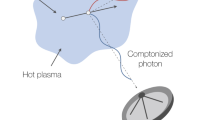Abstract
Sometimes the most beautiful things are the hardest to understand. Pillars like those of the Eagle Nebula form at the boundary between some of the hottest (10000~K) and coldest (10~K) gas in the Galaxy. Many physical processes come into play in the birth and growth of such gaseous pillars: hydrodynamic instability, photoionization, ablation, recombination, molecular heating and cooling, and probably magnetic fields. High-quality astronomical observations, quantitative numerical simulations, and scaled laser experiments provide a powerful combination for understanding their formation and evolution.
We put our most recent hydrodynamic model to the test, by creating simulated observations from it and comparing them directly to the actual radioastronomical observations. Successfully reproducing major characteristics of the observations in this manner is an important step in designing appropriate laser experiments.
Similar content being viewed by others
References
Bertoldi, F., McKee, C.F.: ApJ 354, 529 (1990)
Frieman, E.A.: ApJ 120, 18 (1954)
Mizuta, A., Kane, J.O., Pound, M.W., Remington, B.A., Ryutov, D.D., Takabe, H.: ApJ 621, 803 (2005)
Mizuta, A., Takabe, H., Kane, J.O., Pound, M.W., Remington, B.A. Ryutov, D.D.: Astrophysics & Space Science 298, 197 (2005)
Pound, M.W.: ApJ 493, L113–L116 (1998)
Pound, M.W., Reipurth, B., Bally, J.: AJ 125, 2108 (2003)
Pound, M.W., Kane, J.O., Remington, B.A., Ryutov, D.D., Mizuta, A., Takabe, H.: Astrophysics & Space Science 298, 177 (2005)
Reipurth, B.: A&A 117, 183 (1983)
Ryutov, D., Kane, J., Mizuta, A., Pound, M., Remington, B.: APS Meeting Abstracts, 1004P (2002)
Spitzer, L.: ApJ 120, 1 (1954)
Williams, R.J.R., Ward-Thompson, D., Whitworth, A.P.: MNRAS 327, 788 (2001)
Author information
Authors and Affiliations
Rights and permissions
About this article
Cite this article
Pound, M.W., Kane, J.O., Ryutov, D.D. et al. Pillars of Heaven. Astrophys Space Sci 307, 187–190 (2007). https://doi.org/10.1007/s10509-006-9214-9
Received:
Accepted:
Published:
Issue Date:
DOI: https://doi.org/10.1007/s10509-006-9214-9




